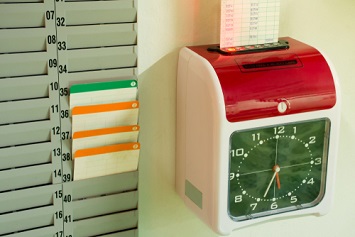Under the Fair Labor Standards Act (FLSA), employers must maintain records of hours worked by each nonexempt employee. That means companies bear the ultimate burden of showing that records of hours worked are in fact accurate. If an employer is sued by an employee, a group of employees, or the U.S. Department of Labor (DOL) for off-the-clock work or unpaid overtime, it must have defensible record-keeping practices. If it doesn’t, the employee’s own—typically inflated—estimate of hours worked will likely control. As a facilities manager, you may think this is all up to human resources (HR) to keep track of—but as a manager and supervisor, you need to set the example and stick to policy to stay compliant in your facilities department. Here are 5 tips for doing so.

Dhammarat Nunart / Shutterstock.com
Whether your employees record their hours electronically or use paper timesheets or punch clocks, it is critical to take reasonable steps to ensure that time records accurately reflect all hours worked. While no safeguards are foolproof (especially if nonexempt employees travel, work “in the field,” or telecommute), here are five suggestions for reducing risk:
- Tell employees which timekeeping practices are forbidden. As with compliance with most employment laws, it all starts with the employer’s policy. Make sure your timekeeping policy clearly states what is and is not allowed. That includes, at a minimum, a clear prohibition against off-the-clock work (especially checking e-mail after hours). Additionally, require employees to obtain approval before working overtime. While you still must pay employees for all hours worked (including overtime), employees who do not obtain preapproval may be written up or disciplined. Also, provide a complaint procedure that encourages employees to report timekeeping concerns.
- Require employees to confirm the accuracy of time records. There is always a risk that employees will later argue that they worked more than their records reflect. To combat that, require employees to review and sign off on the accuracy of their time records. An affirmative act by employees (such as clicking a box, typing in an identification number, or signing an acknowledgment) is most effective. That will not prevent employees from later challenging the accuracy of their time records. However, if they do, they will at least be forced to contradict their own confirmations.
- Ensure that records reflect all changes. Ideally, supervisors should never change employees’ time records. Instead, give supervisors the option to either “accept” or “reject” time sheets, and send rejections back to employees with an explanation of why their time sheets were rejected. Employees would then correct and resubmit the entry and reverify the accuracy of the corrected records. However, if supervisors are allowed to edit employees’ time, ensure that employees’ original entries and supervisors’ edits can be easily viewed and tracked. Audit trails are included in most timekeeping software. If you use paper time sheets, make sure to attach the original time sheet and document all corrected entries on a separate, amended time sheet.
- Round with caution. Generally, you may round employees’ time to a quarter hour. You may round down employees’ time seven minutes. In turn, you must round up employees’ time eight to 14 minutes and count it as a quarter hour. Rounding carries significant risk and should be done only with the advice of counsel. If you round, periodically audit time records to make sure that the rounded time roughly cancels out because rounding cannot result in a net loss to employees. In other words, if rounding benefits the company a disproportionate amount of the time, the practice should be revised or eliminated.
- Don’t make automatic deductions. Short breaks are compensable time, but uninterrupted rest and meal breaks of 30 minutes or more are not. Many timekeeping systems allow employers to automatically deduct rest and meal breaks from employees’ work time. Never use this option because that is how collective actions are born. Instead, require employees to record the actual amount of time taken for meal periods.
Whatever method you use to record work time, it is critical to conduct periodic audits to ensure that the information coming from your timekeeping system is consistent with reality. Especially focus on employees whose hours show no fluctuation (i.e., their entries are all “9:00 a.m. to 5:00 p.m.”). Again, no method is foolproof, but employers that make an effort to check the accuracy of employee timekeeping records almost always fare better in court than those that do not.
| Willliam Hammel is a partner in the Dallas office of Constangy, Brooks, Smith & Prophete, LLP and a contributor to Texas Employment Law Letter. He can be reached at whammel@constangy.com. |
